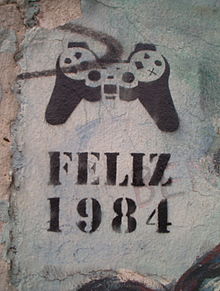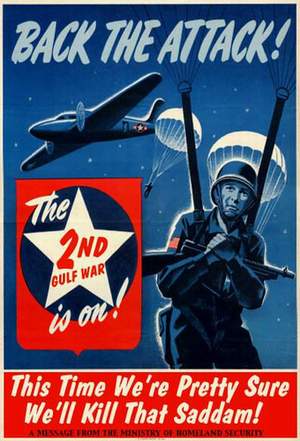Aside from my passion for political art and propaganda, I have a keen interest in documentaries. Combine the two, and I’m in heaven.
Lately, my interest has been piqued by documentaries about graffiti, whether or not the art shown and discussed is politically themed. Because so many of the political art pieces I discuss are works of graffiti, I decided it makes sense to learn more about the art form itself.
Hence, last night: I watched the documentary Infamy, which catalogues the lives and minds of six of America’s most prolific and political graffiti artists. Viewers are introduced to the world of street legends Saber, Toomer, Jase, Claw, Earsnot, and Enem. Interesting characters—all of them. Saber’s designs are mathematically complex; Toomer is part of a graffiti gang; Jase has a fetish for slamming trains with graffiti in particular, but the fumes from countless paint cans are beginning to threaten his health; Claw is perhaps the only notorious girl graffiti artist; Earsnot is breaking stereotypes as a gay, African American graffiti artist in the hardened streets of the Bronx; and Enem is devising a revolutionary new graffiti style in Philadelphia.
With tell-all honesty, these artists reveal why they are so willing to risk everything to spray paint their cities with graffiti images. From the streets of the Bronx to a San Francisco tunnel, from high atop a Hollywood city billboard to the walls of Philadelphia, from the Mexican border to a Cleveland train yard, Infamy analyzes and glorifies graffiti through a simulated viewing experience.

EXPLORING GRAFFITI LEGENDS - Infamy, a documentary on six of the most legendary American graffiti artists, explores the reasons behind why writers risk it all to get their art on the street.
Adding depth to the documentary, the conflict between graffiti artists and local law enforcement is explored as both sides seek to answer the question: is graffiti art or crime? The audience also meets Joe “The Graffiti Guerrilla” Connolly, a notorious and well-known “buffer” who clearly views graffiti as the latter. With a vengeance matched only by the artists who produced them, Joe paints over graffiti murals and markings in his neighborhood, determined to keep the area free from vandalism. He even warns potential vandals to take their dealings elsewhere with a sign reading, “Graffiti no longer accepted here. Find a day job please!”
Watching the documentary, I had no idea that graffiti was such a territorial art. For an artist to be taken seriously, he must claim entire sections of a neighborhood by spraying and tagging his designs on every available surface—walls, buildings, lampposts, post office boxes, doors, road and traffic signs, etc. Furthermore, he must maintain his designs by repeatedly coming back and checking that no one has painted over them or drawn something on top of them—a major offense in the graffiti world.
While such offenses among artists competing for fame are common, offenses and run-ins with the law are almost just as frequent. Every one of the six legends has faced either criminal charges or repeated warnings from law enforcement. Yet, despite potential ramifications and repercussions, they all continue to create their art illegally, often sneaking out at all hours of the night or lying to cops outright in the middle of the day about permission to paint a particular area. When asked why they risk it, they all give different answers, ranging from “graffiti is like an addiction” to “the kids like it” to “it’s personal.” But my favorite answer was Toomer’s: “It’s like the people who carved Mount Rushmore. They wanted to leave a mark, and that’s all we’re doing. It’s the same thing.”
Just make sure you brush up on your graffiti vocabulary beforehand. For a relative graffiti novice like me, prior knowledge of the following lingo would have been most helpful:
Bomb: to paint many surfaces in an area.
Heavens: pieces that are painted in hard-to-reach places such as rooftops and freeway signs, thus making them hard to remove. Such pieces often pose dangerous challenges to execute, but may increase an artist’s notoriety.
Piece: a large and labor-intensive graffiti painting (short for masterpiece). They often incorporate 3-D effects, arrows, and many colors and are considered the full and most beautiful work of graffiti. A piece requires more time to paint than a throw-up. If placed in a difficult location and well executed it will earn the writer more respect (also called murals).
Racking: shoplifting or robbing, not limited to but including paint, markers, inks, caps, and clothes.
Tags: a stylized signature, normally done in one color. The simplest and most prevalent type of graffiti, a tag is often done in a color that contrasts sharply with its background. Tag can also be used as a verb meaning “to sign.” Writers often tag on or beside their pieces, following the practice of traditional artists who sign their artwork.
Throw-up: a throw-up or “throwie” sits between a tag and a piece in terms of complexity and time investment. It generally consists of a one-color outline and one layer of fill-color. Easy-to-paint bubble shapes often form the letters. A throw-up is designed for quick execution, to avoid attracting attention to the writer. Throw-ups are often utilized by writers who wish to achieve a large number of tags while competing with rival artists. Most artists have both a tag and a throw-up that are essentially fixed compared to pieces. This way, they have a recognizable logo for others to identify them and a mark that characterizes their own individual styles.
Writer: a graffiti artist.


















